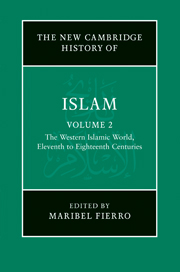Book contents
- Frontmatter
- Introduction
- PART I AL-ANDALUS AND NORTH AND WEST AFRICA (ELEVENTH TO FIFTEENTH CENTURIES)
- PART II EGYPT AND SYRIA (ELEVENTH CENTURY UNTIL THE OTTOMAN CONQUEST)
- PART III MUSLIM ANATOLIA AND THE OTTOMAN EMPIRE
- PART IV NORTH AND WEST AFRICA (SIXTEENTH TO EIGHTEENTH CENTURIES)
- 16 Sharīfian rule in Morocco (tenth–twelfth/sixteenth–eighteenth centuries)
- 17 West Africa (tenth–twelfth/sixteenth–eighteenth centuries)
- 18 Ottoman Maghrib
- PART V RULERS, SOLDIERS, PEASANTS, SCHOLARS AND TRADERS
- Glossary
- Bibliography
- Index
- References
18 - Ottoman Maghrib
from PART IV - NORTH AND WEST AFRICA (SIXTEENTH TO EIGHTEENTH CENTURIES)
Published online by Cambridge University Press: 28 March 2011
- Frontmatter
- Introduction
- PART I AL-ANDALUS AND NORTH AND WEST AFRICA (ELEVENTH TO FIFTEENTH CENTURIES)
- PART II EGYPT AND SYRIA (ELEVENTH CENTURY UNTIL THE OTTOMAN CONQUEST)
- PART III MUSLIM ANATOLIA AND THE OTTOMAN EMPIRE
- PART IV NORTH AND WEST AFRICA (SIXTEENTH TO EIGHTEENTH CENTURIES)
- 16 Sharīfian rule in Morocco (tenth–twelfth/sixteenth–eighteenth centuries)
- 17 West Africa (tenth–twelfth/sixteenth–eighteenth centuries)
- 18 Ottoman Maghrib
- PART V RULERS, SOLDIERS, PEASANTS, SCHOLARS AND TRADERS
- Glossary
- Bibliography
- Index
- References
Summary
Introduction
Ibn Khaldūn’s description of the Maghrib of his day is a striking one, one which, as might be expected, illustrates his theory of the fall of civilisations. The Maghrib he describes labours under all kinds of troubles: the impoverishment and weakening of its states, worsening of its peoples’ living conditions, the waning of its trade (particularly with the Sūdān) and the deterioration of its cities. The Maghribi scholar sees such a decline in the infrastructure of the area that it appears ‘deserted and empty, with the exception of the coast and the surrounding hills’.
This view is borne out in post-Khaldūnian Maghrib, which sees its states disintegrating, its agriculture deteriorating and its trade collapsing; and then, while the mountains close in on themselves, the plains face disruption by the Bedouin tribes who no longer have the political allegiances which previously held their taste for power in check. Local notables sprang up everywhere, similar to those described in the ninth/fifteenth-century corpus of jurisprudential law known as the Nawāzil of Mazouna. When crossing the Ghrīs plain in 921/1515, Leo Africanus noted that the population fell into two groups: on the one hand, the settled population living in the hills in houses ‘very properly built with walls’ and cultivating the land, with on the other hand the nomads living in tents and tending cattle on the plains. This pattern of habitation of the land and the resultant type of work arising from it grew into a relationship of political domination.
- Type
- Chapter
- Information
- The New Cambridge History of Islam , pp. 503 - 546Publisher: Cambridge University PressPrint publication year: 2010

